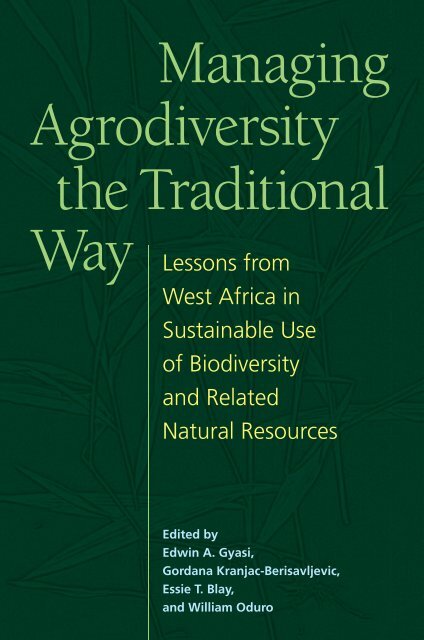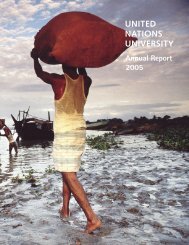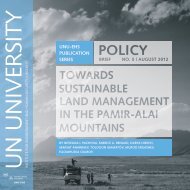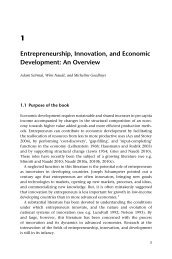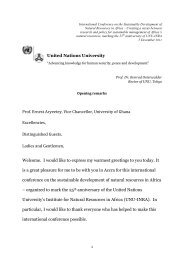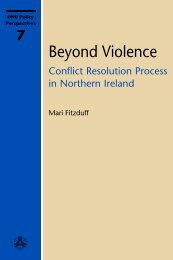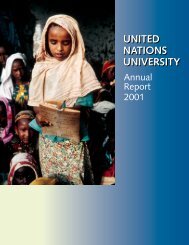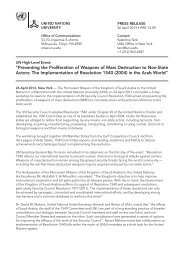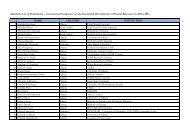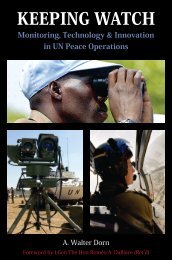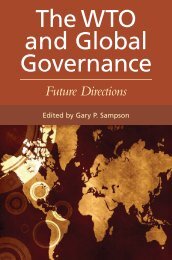Managing Agrodiversity the Traditional Way - United Nations ...
Managing Agrodiversity the Traditional Way - United Nations ...
Managing Agrodiversity the Traditional Way - United Nations ...
Create successful ePaper yourself
Turn your PDF publications into a flip-book with our unique Google optimized e-Paper software.
<strong>Managing</strong><br />
<strong>Agrodiversity</strong><br />
<strong>the</strong> <strong>Traditional</strong><br />
<strong>Way</strong><br />
Lessons from<br />
West Africa in<br />
Sustainable Use<br />
of Biodiversity<br />
and Related<br />
Natural Resources<br />
Edited by<br />
Edwin A. Gyasi,<br />
Gordana Kranjac-Berisavljevic,<br />
Essie T. Blay,<br />
and William Oduro
<strong>Managing</strong> agrodiversity <strong>the</strong> traditional<br />
way: Lessons from West Africa in<br />
sustainable use of biodiversity and<br />
related natural resources<br />
Edited by Edwin A. Gyasi, Gordana Kranjac-Berisavljevic,<br />
Essie T. Blay, and William Oduro
Contents<br />
List of tables and illustrations . . . . . . . . . . . . . . . . . . . . . . . . . . . . . . . .<br />
List of colour plates . . . . . . . . . . . . . . . . . . . . . . . . . . . . . . . . . . . . . . .<br />
viii<br />
xiii<br />
Maps<br />
A Major ecological/vegetation zones of West Africa . . . . . . . . . . . . . xiv<br />
B Major agro-ecological zones and PLEC demonstration sites<br />
in Ghana . . . . . . . . . . . . . . . . . . . . . . . . . . . . . . . . . . . . . . . . . . . . xv<br />
C Gyamfiase-Adenya demonstration site . . . . . . . . . . . . . . . . . . . . . . xvi<br />
D Sekesua-Osonson demonstration site . . . . . . . . . . . . . . . . . . . . . . . xvii<br />
E Amanase-Whanabenya demonstration site . . . . . . . . . . . . . . . . . . . xviii<br />
Preface<br />
Edwin A. Gyasi . . . . . . . . . . . . . . . . . . . . . . . . . . . . . . . . . . . . .<br />
Foreword<br />
Harold Brookfield . . . . . . . . . . . . . . . . . . . . . . . . . . . . . . . . . . .<br />
Acknowledgements<br />
Edwin A. Gyasi, Gordana Kranjac-Berisavljevic, Essie T. Blay,<br />
and William Oduro . . . . . . . . . . . . . . . . . . . . . . . . . . . . . . . . . .<br />
xix<br />
xxiii<br />
xxvii<br />
Part I Methodological approaches and knowledge systems<br />
1 Methodological approaches to <strong>the</strong> book<br />
Edwin A. Gyasi . . . . . . . . . . . . . . . . . . . . . . . . . . . . . . . . . . . . . 3<br />
2 Philosophical foundations of biophysical resource use with special<br />
reference to Ghana<br />
Alfred A. Oteng-Yeboah . . . . . . . . . . . . . . . . . . . . . . . . . . . . . . . 8<br />
v
vi<br />
CONTENTS<br />
3 <strong>Traditional</strong> methods of resource assessment relative to <strong>the</strong> scientific<br />
approach<br />
Stephen Nkansa Buabeng . . . . . . . . . . . . . . . . . . . . . . . . . . . . . . 14<br />
4 Farmer strategies of managing agrodiversity in a variable climate in<br />
PLEC demonstration sites in sou<strong>the</strong>rn Ghana<br />
Edward Ofori-Sarpong and Felix Asante . . . . . . . . . . . . . . . . . . . 25<br />
5 Demonstration sites and expert farmers in conservation of<br />
biodiversity<br />
Edwin A. Gyasi . . . . . . . . . . . . . . . . . . . . . . . . . . . . . . . . . . . . . . 38<br />
Part II Cropping systems and related case studies<br />
6 Management regimes in sou<strong>the</strong>rn Ghana<br />
Edwin A. Gyasi . . . . . . . . . . . . . . . . . . . . . . . . . . . . . . . . . . . . . . 53<br />
7 Yams: <strong>Traditional</strong> ways of managing <strong>the</strong>ir diversity for food security<br />
in sou<strong>the</strong>rn Ghana<br />
Essie T. Blay . . . . . . . . . . . . . . . . . . . . . . . . . . . . . . . . . . . . . . . . 69<br />
8 Sustaining diversity of yams in nor<strong>the</strong>rn Ghana<br />
Gordana Kranjac-Berisavljevic and Bizoola Z. Gandaa . . . . . . . 84<br />
9 Conservation of indigenous rice varieties by women of Gore in <strong>the</strong><br />
nor<strong>the</strong>rn savanna zone, Ghana<br />
Paul B. Tanzubil, Joseph S. Dittoh, and Gordana Kranjac-<br />
Berisavljevic . . . . . . . . . . . . . . . . . . . . . . . . . . . . . . . . . . . . . . . . 97<br />
10 Vegetables: <strong>Traditional</strong> ways of managing <strong>the</strong>ir diversity for food<br />
security in sou<strong>the</strong>rn Ghana<br />
Essie T. Blay . . . . . . . . . . . . . . . . . . . . . . . . . . . . . . . . . . . . . . . . 106<br />
11 The proka mulching and no-burn system: A case study of<br />
Tano-Odumasi and Jachie<br />
Charles Quansah and William Oduro . . . . . . . . . . . . . . . . . . . . . 119<br />
12 <strong>Managing</strong> <strong>the</strong> home garden for food security and as a germplasm bank<br />
Lewis Enu-Kwesi, Edwin A. Gyasi, and Vincent V. Vordzogbe . . . 135<br />
13 Management of trees in association with crops in traditional<br />
agroforestry systems<br />
John A. Poku . . . . . . . . . . . . . . . . . . . . . . . . . . . . . . . . . . . . . . . 155
CONTENTS<br />
vii<br />
14 Preliminary observations on effects of traditional farming practices<br />
on growth and yield of crops<br />
Leonard Asafo, Ebenezer Laing, Lewis Enu-Kwesi, and<br />
Vincent V. Vordzogbe . . . . . . . . . . . . . . . . . . . . . . . . . . . . . . . . . . . . 165<br />
15 Effects of four indigenous trees canopy covers on soil fertility in a<br />
Ghanaian savanna<br />
Charles Anane-Sakyi, Abubakari Sadik Abdulai, and Saa Dittoh . . 177<br />
16 Comparative management of <strong>the</strong> savanna woodland in Ghana and<br />
Guinea: A preliminary analysis<br />
Lewis Enu-Kwesi, Vincent V. Vordzogbe, Diallo Amirou, and<br />
Diallo Daouda . . . . . . . . . . . . . . . . . . . . . . . . . . . . . . . . . . . . . . . . . . . 187<br />
17 <strong>Agrodiversity</strong> within and without conserved forests for enhancing<br />
rural livelihoods<br />
Essie T. Blay, Benjamin D. Ofori, John Heloo, Joachim B. Ofori,<br />
and Emmanuel Nartey . . . . . . . . . . . . . . . . . . . . . . . . . . . . . . . . 203<br />
Part III Social dimensions of resource management<br />
18 Aspects of resource tenure that conserve biodiversity: The case of<br />
sou<strong>the</strong>rn and nor<strong>the</strong>rn Ghana<br />
Edwin A. Gyasi and William J. Asante . . . . . . . . . . . . . . . . . . . . 217<br />
19 Resource access and distribution and <strong>the</strong> use of land in<br />
Tano-Odumasi, central Ghana<br />
John A. Bakang, William Oduro, and Kwaku A. Nkyi . . . . . . . . . 228<br />
20 Women environmental pacesetters of Jachie<br />
Olivia Agbenyega and William Oduro . . . . . . . . . . . . . . . . . . . . . 242<br />
Part IV Conclusion<br />
21 Lessons learnt and future research directions<br />
Edwin A. Gyasi . . . . . . . . . . . . . . . . . . . . . . . . . . . . . . . . . . . . . . 253<br />
Contributors . . . . . . . . . . . . . . . . . . . . . . . . . . . . . . . . . . . . . . . . . . . . . 257<br />
Index . . . . . . . . . . . . . . . . . . . . . . . . . . . . . . . . . . . . . . . . . . . . . . . . . . . 259
1<br />
Methodological approaches to <strong>the</strong> book<br />
Edwin A. Gyasi<br />
<strong>Agrodiversity</strong> defined<br />
Through case studies in West Africa (principally Ghana; Maps A and B) and<br />
drawing from nearly 10 years of research experience of <strong>the</strong> <strong>United</strong> <strong>Nations</strong><br />
University project on People, Land Management, and Environmental Change<br />
(UNU/PLEC), this book demonstrates <strong>the</strong> importance of traditional, indigenous,<br />
or local farmer knowledge and practices in sustainable conservation of biodiversity<br />
and related natural resources by agrodiversity.<br />
<strong>Agrodiversity</strong> refers to <strong>the</strong> processes and products of agricultural diversification.<br />
In more elaborate terms, it is “<strong>the</strong> many ways in which farmers use <strong>the</strong><br />
natural diversity of <strong>the</strong> environment for production, including not only <strong>the</strong>ir<br />
choice of crops but also <strong>the</strong>ir management of land, water and biota as a whole”<br />
(Brookfield and Padoch, 1994: 9). It comprises four principal elements,<br />
namely:<br />
• management diversity, which refers to <strong>the</strong> various methods of managing <strong>the</strong><br />
land and associated biophysical resources for agricultural purposes<br />
• agrobiodiversity, which describes <strong>the</strong> “management and direct use of biological<br />
species, including all crops, semi-domesticates and wild species” (Huijun,<br />
Zhiling, and Brookfield, 1996: 15)<br />
• biophysical diversity, which refers to <strong>the</strong> various soil characteristics and <strong>the</strong>ir<br />
productivity, and <strong>the</strong> biodiversity of natural (or spontaneous) plant life and <strong>the</strong><br />
soil biota<br />
3
4 GYASI<br />
• organizational diversity, which describes <strong>the</strong> diverse socio-economic aspects of<br />
farming such as tenurial arrangements, household characteristics, and gender<br />
roles (Brookfield, Stocking, and Brookfield, 1999; see also Brookfield 2001;<br />
Brookfield et al., 2002).<br />
In varying degrees, <strong>the</strong> case studies that form <strong>the</strong> core of <strong>the</strong> book illustrate all<br />
four elements of agrodiversity.<br />
It is believed that agrodiversity has <strong>the</strong> virtue of:<br />
• streng<strong>the</strong>ning biodiversity<br />
• imparting ecological stability<br />
• providing a genetic pool of plants and animals needed for breeding higheryielding<br />
varieties for food security<br />
• facilitating dietary diversity<br />
• contributing to “(1) increased resource productivity over time, (2) increase in<br />
<strong>the</strong> amount and quality of labour applied to <strong>the</strong> farm, and (3) insurance and risk<br />
reduction at household enterprise level” (Netting and Stone, 1996: 53; see also<br />
<strong>the</strong> o<strong>the</strong>r articles in Africa, Vol. 66, and Brush, 2000).<br />
Historical context<br />
The mainly econcentric case studies of <strong>the</strong> book (Jones and Hollier, 1997) are<br />
rooted in <strong>the</strong> pilot West African PLEC (WAPLEC) work, which was initiated in<br />
<strong>the</strong> year 1993, with a focus on understanding agro-environmental changes and<br />
farmers’ role in and reactions to <strong>the</strong>m.<br />
That initial, basically investigative work involved studies in three principal<br />
sites, centred on Yensiso (subsequently renamed Gyamfiase-Adenya), Sekesua<br />
(subsequently renamed Sekesua-Osonson), and Amanase (renamed Amanase-<br />
Whanabenya), all located in <strong>the</strong> sou<strong>the</strong>rn sector of Ghana’s forest-savanna<br />
transition zone (Maps B, C, D, E). The principal outputs of those studies, carried<br />
out by scientists from <strong>the</strong> University of Ghana, Legon, were:<br />
• <strong>the</strong> development of research links with farmers and increased insights into<br />
agro-ecological transformations, which served as a basis for fur<strong>the</strong>r work<br />
• <strong>the</strong> scientific paper “Production pressure and environmental change in <strong>the</strong><br />
forest-savanna of sou<strong>the</strong>rn Ghana” (Gyasi et al., 1995)<br />
• <strong>the</strong> book Environment, Biodiversity and Agricultural Change in West Africa:<br />
Perspectives from Ghana (Gyasi and Uitto, 1997).<br />
Subsequently, <strong>the</strong> work was extended to additional sites in Ghana’s remaining<br />
major agro-ecological zones, namely humid forest and dry savanna, and in wooded<br />
savanna portions of <strong>the</strong> Fouta Djallon mountains of <strong>the</strong> Republic of Guinea (Maps<br />
A, B, C, D, E). The extension was facilitated by:<br />
• integration of more scientists from <strong>the</strong> University of Ghana, and of additional<br />
ones from <strong>the</strong> Kwame Nkrumah University of Science and Technology
METHODOLOGICAL APPROACHES TO THE BOOK 5<br />
(KNUST) and University for Development Studies (UDS), both in Ghana, and<br />
<strong>the</strong> Université de Conakry in <strong>the</strong> Republic of Guinea<br />
• increased collaboration with farmers.<br />
From about 1997, <strong>the</strong> focus shifted to:<br />
• identification of those aspects of farmer resource usage that appear to favour<br />
agrodiversity<br />
• demonstration and improvement of sustainable agrodiversity management<br />
practices as a way of meeting simultaneously <strong>the</strong> triple objectives of conserving<br />
biodiversity, streng<strong>the</strong>ning food security, and enhancing rural livelihoods.<br />
Methodology<br />
The ensuing case studies mainly contain <strong>the</strong> findings of <strong>the</strong> post-1997 PLEC<br />
research. In carrying out that work and <strong>the</strong> maiden work that preceded it, participatory<br />
procedures were commonly followed by <strong>the</strong> research scientists.<br />
The participatory procedures involved learning farmer practices and <strong>the</strong>ir<br />
underpinning knowledge by close collaborative work between <strong>the</strong> multidisciplinary<br />
teams of scientists and <strong>the</strong> farmers through:<br />
• group discussions<br />
• farm visits<br />
• joint on-farm experiments and o<strong>the</strong>r forms of cooperative ventures within <strong>the</strong><br />
selected project focal sites (Map B).<br />
These activities were facilitated by collaboration with governmental and nongovernmental<br />
agencies, and by farmer associations in which, as discussed in<br />
Chapter 5, expert farmers played a central role, especially as sources of local<br />
knowledge and as mediators with o<strong>the</strong>r farmers. Overall, <strong>the</strong> farmer associations<br />
were composed of a mix of males and females numbering more than 1,300 people.<br />
In <strong>the</strong> work with <strong>the</strong> farmers (PLEC members as well as non-PLEC members),<br />
special emphasis was placed upon understanding how, on <strong>the</strong> basis of traditional<br />
knowledge, farmers manage agrodiversity. Because traditional knowledge reflects<br />
local conditions including popular values, it can be assumed to offer a sounder<br />
basis for developing more locally adaptive resource management models in line<br />
with <strong>the</strong> grassroots, bottom-up development paradigm. Seen in this vein, traditional<br />
or indigenous knowledge may be said to be “complementary to conventional<br />
science” (Brokensha, Warren, and Werner, 1980: 8; see also Richards,<br />
1985; Chambers, Pacey, and Thrupp, 1989; Benedict and Christofferson, 1996;<br />
Chambers, 1998; Mammo, 1999; Van den Breemer, Drijver, and Venema, 1995;<br />
Haverkort, van’t Hooft, and Hiemstra, 2003).<br />
All <strong>the</strong> three principal teams of PLEC research scientists based, respectively at<br />
<strong>the</strong> University of Ghana, Kwame Nkrumah University of Science and Technology,<br />
and <strong>the</strong> University for Development Studies equally followed <strong>the</strong> multidisciplinary
6 GYASI<br />
approach. It involved discussions with farmers, biodiversity assessment (Zarin,<br />
Huijun, and Enu-Kwesi, 1999), computer programming of information generated,<br />
and <strong>the</strong> discharge of o<strong>the</strong>r work aspects on a joint basis by <strong>the</strong> teams of scientists<br />
and o<strong>the</strong>r experts drawn from a diversity of specializations – botany, soils science,<br />
crop science, o<strong>the</strong>r biophysical sciences, agricultural economics, geography, and<br />
o<strong>the</strong>r social sciences. But <strong>the</strong> team approach was pursued without sacrificing individual<br />
disciplinary perspectives, particularly with regard to <strong>the</strong> interpretation of<br />
<strong>the</strong> information generated through <strong>the</strong> multidisciplinary teamwork.<br />
REFERENCES<br />
Benedict, F. and L. E. Christofferson, eds, Environment and Development in Africa:<br />
Participatory Processes and New Partnerships, Copenhagen: Scandinavian Seminar<br />
College, 1996.<br />
Brokensha, D. W., D. W. Warren, and O. Werner, eds, Indigenous Knowledge Systems and<br />
Development, Boston: University Press of America, 1980.<br />
Brookfield, H., Exploring <strong>Agrodiversity</strong>, New York: Columbia University Press, 2001.<br />
Brookfield, H. and C. Padoch, “Appreciating agrodiversity: A look at <strong>the</strong> dynamics and diversity<br />
of indigenous farming systems”, Environment, Vol. 36, No. 5, 1994, pp. 6–11, 36–45.<br />
Brookfield, H., M. Stocking, and M. Brookfield, “Guidelines on agrodiversity assessment<br />
in demonstration site areas (Revised to form a companion paper to <strong>the</strong> BAG guidelines)”,<br />
PLEC News and Views, No. 13, 1999, pp. 17–31.<br />
Brookfield, H., C. Padoch, H. Parsons, and M. Stocking, “Cultivating Biodiversity: Setting<br />
<strong>the</strong> scene” in H. Brookfield, C. Padoch, H. Parsons, and M. Stocking, eds, Cultivating<br />
Biodiversity: Understanding, Analysing and Using Agricultural Diversity, London:<br />
ITDG Publishing, 2002, pp. 1–8.<br />
Brush, S. B., Genes in <strong>the</strong> Field: On-Farm Conservation of Crop Diversity, Boca Raton:<br />
Lewis Publishers, 2000.<br />
Chambers, R., “Behaviour and attitudes: A missing link in agricultural science”, in<br />
V. L. Chopra, R. B. Singh, and A. Varma, eds, Crop Productivity and Sustainability,<br />
Proceedings of 2nd International Crop Science Congress, New Delhi: Oxford<br />
University Press and IBH Publishing, 1998.<br />
Chambers, R., A. Pacey, and L. A. Thrupp, eds, Farmer First: Farmer Innovation and<br />
Agricultural Research, London: Intermediate Technology Publications, 1989.<br />
Gyasi, E. A. and J. I. Uitto, eds, Environment, Biodiversity and Agricultural Change in<br />
West Africa: Perspectives from Ghana, Tokyo: <strong>United</strong> <strong>Nations</strong> University Press, 1997.<br />
Gyasi, E. A., G. T. Agyepong, E. Ardayfio Schandorf, L. Enu-Kwesi, J. S. Nabila, and<br />
E. Owusu-Bennoah, “Production pressure and environmental change in <strong>the</strong><br />
forest-savanna zone of sou<strong>the</strong>rn Ghana”, Global Environmental Change, Vol. 5, No. 4,<br />
1995, pp. 355–366.<br />
Haverkort, B., K. van’t Hooft, and W. Hiemstra, eds, Ancient Roots, New Shoots:<br />
Endogenous Development in Practice, Leusden: ETC/Compas, 2003.<br />
Huijun, G., D. Zhiling, and H. Brookfield, “<strong>Agrodiversity</strong> and biodiversity on <strong>the</strong> ground and<br />
among <strong>the</strong> people: Methodology from Yunnan”, PLEC News and Views, No. 6, 1996, p. 15.
METHODOLOGICAL APPROACHES TO THE BOOK 7<br />
Jones, G. and G. Hollier, Resources, Society and Environmental Management, London:<br />
Chapman Publishing, 1997.<br />
Mammo, T., The Paradox of Africa’s Poverty: The Role of Indigenous Knowledge,<br />
<strong>Traditional</strong> Practices and Local Institutions – The Case of Ethiopia, Lawrenceville and<br />
Asmara: Red Sea Press, 1999.<br />
Netting, R. M. and M. P. Stone, “Agro-diversity on a farming frontier: Kofyar smallholders<br />
on <strong>the</strong> Benue plains of central Nigeria”, Africa, Vol. 66, No. 1, 1996, pp. 52–70.<br />
Richards, P., Indigenous Agricultural Revolution: Ecology and Food Production in West<br />
Africa, London: Hutchinson, 1985.<br />
Van den Breemer, J. P. M., C. A. Drijver, and L. B. Venema, eds, Local Resource<br />
Management in Africa, Chichester: John Wiley & Sons, 1995.<br />
Zarin, D. J., G. Huijun, and L. Enu-Kwesi, “Methods for <strong>the</strong> assessment of plant species<br />
diversity in complex agricultural landscapes: Guidelines for data collection and analysis<br />
from <strong>the</strong> PLEC Biodiversity Advisory Group (PLEC-BAG)”, PLEC News and Views,<br />
No. 13, 1999, pp. 3–16.
© <strong>United</strong> <strong>Nations</strong> University, 2004<br />
The views expressed in this publication are those of <strong>the</strong> authors and do not<br />
necessarily reflect <strong>the</strong> views of <strong>the</strong> <strong>United</strong> <strong>Nations</strong> University.<br />
<strong>United</strong> <strong>Nations</strong> University Press<br />
The <strong>United</strong> <strong>Nations</strong> University, 53-70, Jingumae 5-chome,<br />
Shibuya-ku, Tokyo, 150-8925, Japan<br />
Tel: 81-3-3499-2811 Fax: 81-3-3406-7345<br />
E-mail: sales@hq.unu.edu (general enquiries): press@hq.unu.edu<br />
www.unu.edu<br />
<strong>United</strong> <strong>Nations</strong> University Office at <strong>the</strong> <strong>United</strong> <strong>Nations</strong>, New York<br />
2 <strong>United</strong> <strong>Nations</strong> Plaza, Room DC2-2062, New York, NY 10017, USA<br />
Tel: 1-212-963-6387 Fax: 1-212-371-9454<br />
E-mail: unuona@ony.unu.edu<br />
<strong>United</strong> <strong>Nations</strong> University Press is <strong>the</strong> publishing division of <strong>the</strong> <strong>United</strong> <strong>Nations</strong><br />
University.<br />
Cover design by Rebecca S. Neimark, Twenty-Six Letters<br />
Printed in <strong>the</strong> <strong>United</strong> States of America<br />
UNUP-1098<br />
ISBN 92-808-1098-7<br />
Library of Congress Cataloging-in-Publication Data<br />
<strong>Managing</strong> agrodiversity <strong>the</strong> traditional way : lessons from West Africa in sustainable use<br />
of biodiversity and related natural resources / edited by Edwin A. Gyasi ... [et al.].<br />
p. cm.<br />
Includes index.<br />
ISBN 92-808-1098-7 (pbk.)<br />
1. Agrobiodiversity—Africa, West. 2. Agrobiodiversity—Africa, West—Case studies.<br />
3. Biological diversity conservation—Africa, West. I. Gyasi, Edwin A. (Edwin Akonno),<br />
1943–<br />
S494.5.A43M352 2004<br />
333.95160966—dc22<br />
2004014198
<strong>Managing</strong> <strong>Agrodiversity</strong> <strong>the</strong> <strong>Traditional</strong> <strong>Way</strong>: Lessons from<br />
West Africa in Sustainable Use of Biodiversity and Related<br />
Natural Resources<br />
Edited by Edwin A. Gyasi, Gordana Kranjac-Berisavljevic, Essie T. Blay<br />
and William Oduro<br />
Contributors:<br />
Edwin A. Gyasi •<br />
Alfred Oteng-Yeboah •<br />
Stephen Nkansa<br />
Buabeng • Edward<br />
Ofori-Sarpong • Felix<br />
Asante • Essie T. Blay<br />
• Gordana Kranjac-<br />
Berisavljevic •<br />
B. Z. Gandaa •<br />
B. Tanzubil •<br />
C. Quansah • W. Oduro<br />
• Lewis Enu-Kwesi •<br />
Vincent Von<br />
Vordzogbe • J. A. Poku<br />
• L. Asafo • E. Laing •<br />
Charles Anane-Sakyi •<br />
A. Sadik Abdulai • J.<br />
Saa Dittoh • D. Amirou •<br />
D. Daouda • Ben D.<br />
Ofori • John Heloo •<br />
J. B. Ofori<br />
• Emmanuel Nartey •<br />
William J. Asante •<br />
J. A. Bakang •<br />
K. A. Nkyi •<br />
Olivia Agbenyega<br />
• William Oduro<br />
Drawing on findings of nearly ten years of <strong>United</strong> <strong>Nations</strong><br />
University Project on People, Land Management and<br />
Environmental Change (UNU/PLEC) multidisciplinary,<br />
participatory research work in West Africa (mainly Ghana), this<br />
book shows how, traditionally, farmers cultivate and conserve<br />
biodiversity while, at <strong>the</strong> same time, using <strong>the</strong> land for food<br />
production. It highlights PLEC interventions for sustaining<br />
agrodiversity for rural livelihoods, as it does lessons for<br />
teaching, policy and development planning.<br />
The book would appeal to policy makers and<br />
practitioners, and to university students and teachers,<br />
including those of agriculture, social science, biological<br />
science and o<strong>the</strong>rs relating to environmental or natural<br />
resources management and sustainable development.<br />
Edwin A. Gyasi is a Professor of Geography and Resource<br />
Development, University of Ghana, Legon, Accra. Gordana<br />
Kranjac-Berisavljevic is Head, Department of Agricultural<br />
Mechanization and Irrigation Technology, University for<br />
Development Studies, Tamale, Ghana. Essie T. Blay is an<br />
Associate Professor, Department of Crop Science, University<br />
of Ghana, Legon, Accra. William Oduro is Director, Institute of<br />
Renewable Natural Resources, Kwame Nkrumah University<br />
of Science and Technology, Kumasi.<br />
Book information:<br />
ISBN 92-808-1098-7;<br />
320pp; US$32.00<br />
Order from:<br />
53-70, Jingumae 5-chome, Shibuya-ku, Tokyo 150-8925, Japan<br />
Tel +81-3-3499-2811; Fax +81-3-3406-7345<br />
E-mail: sales@hq.unu.edu; http://www.unu.edu


